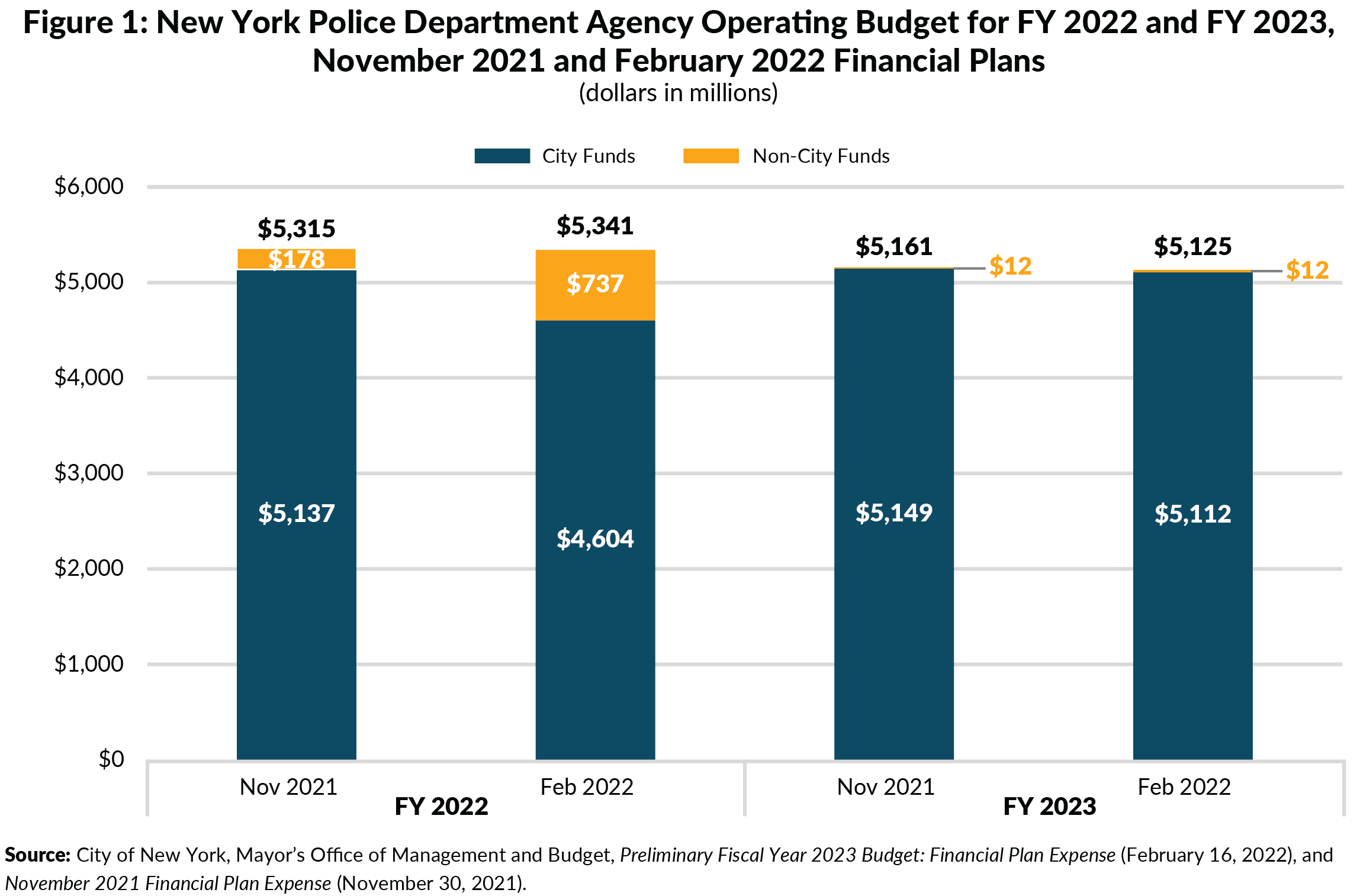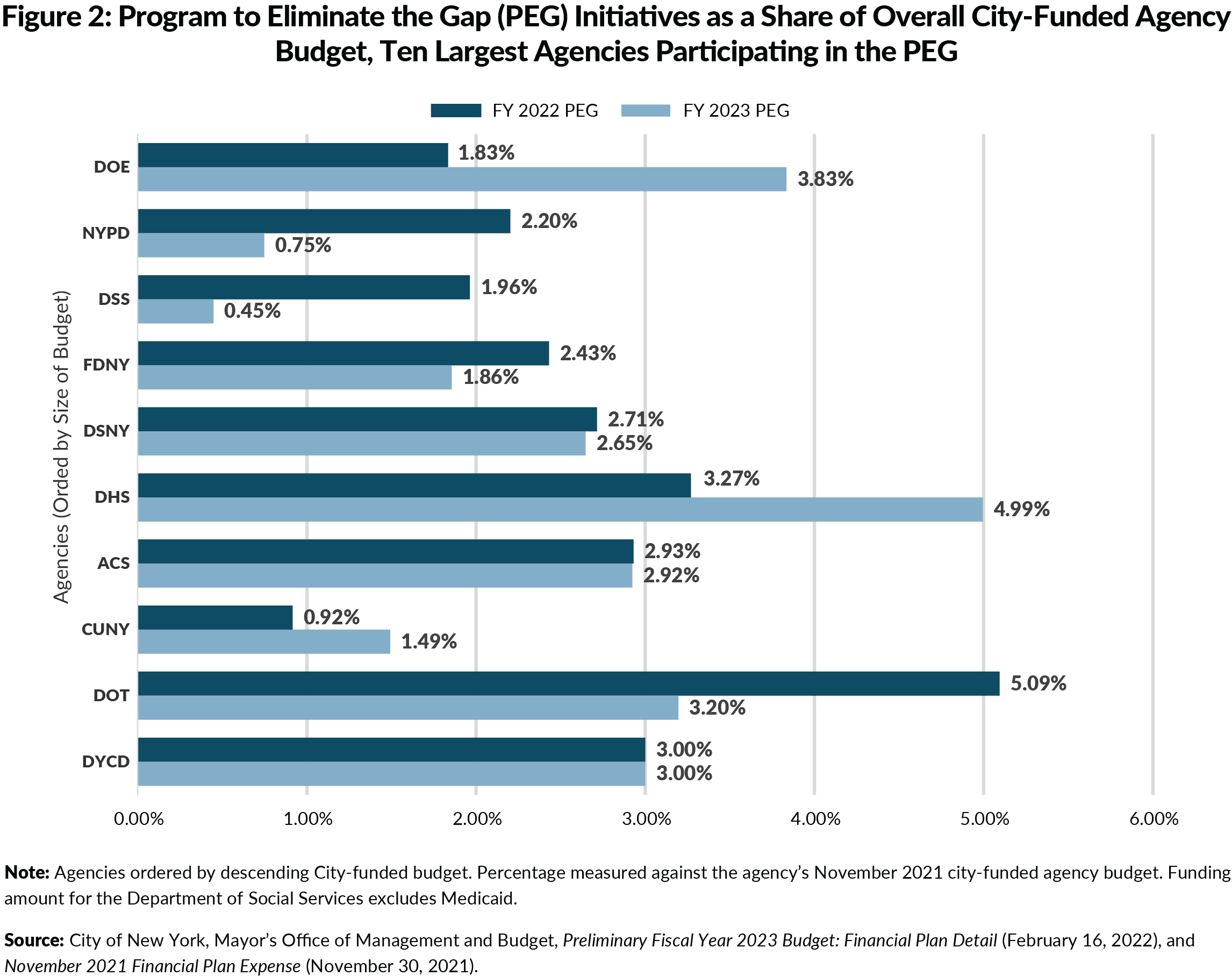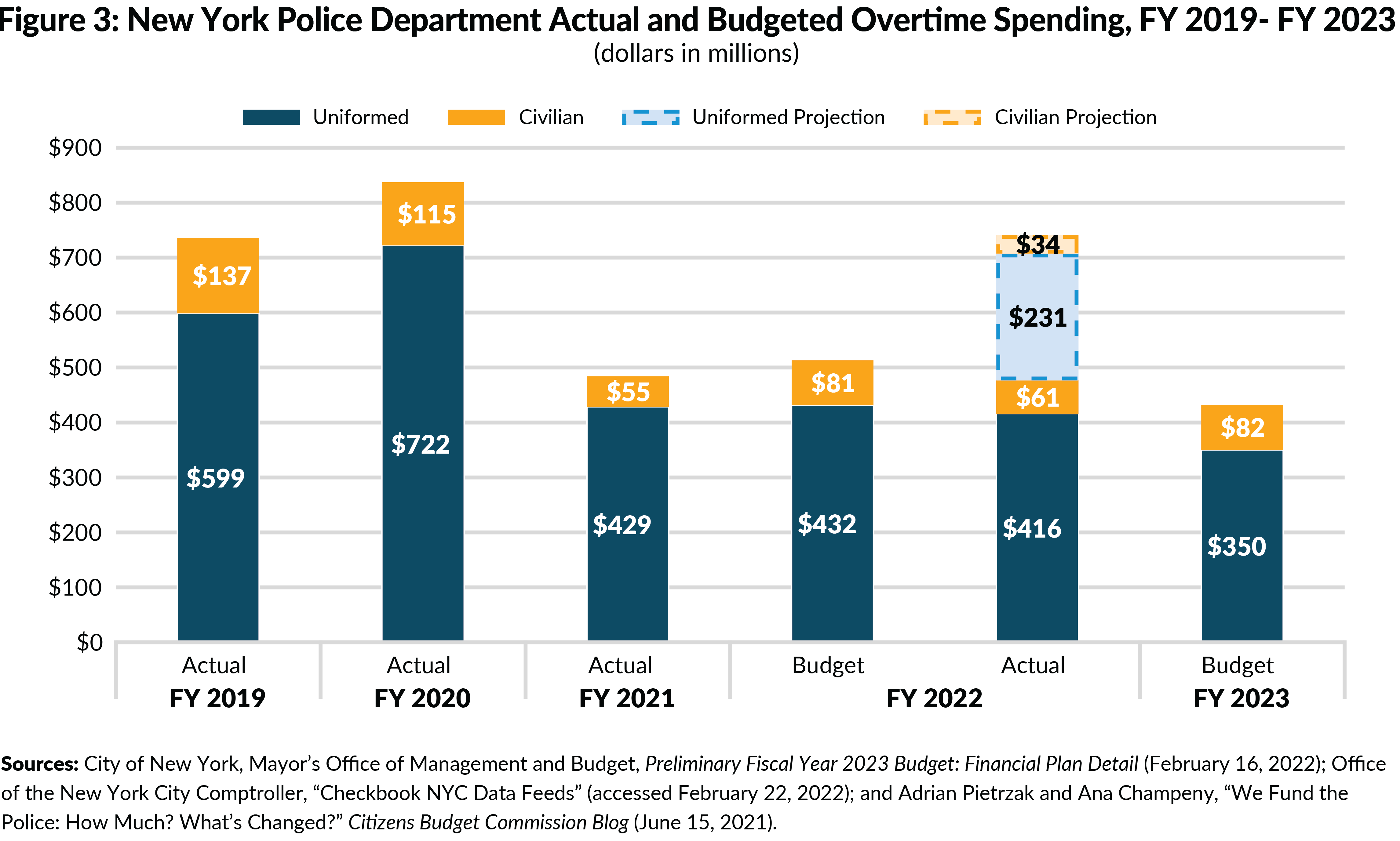Six Fast Facts about the NYPD's Preliminary FY2023 Budget
Public safety is a top issue for New Yorkers, and the New York City Police Department (NYPD) budget continues to garner attention and interest. To implement his Blueprint to End Gun Violence, Mayor Eric Adams did not add new funding to the NYPD budget, choosing instead to redeploy existing resources to implement these new initiatives. Still, the budget is not static: below are six facts to know about the NYPD’s budgets for fiscal years 2022 and 2023, as presented in the February 2022 Financial Plan.
1. The Fiscal Year 2023 NYPD Budget Totals $10.8 Billion, $83 Million Less Than Fiscal Year 2022.
As updated in February 2022, the NYPD budget, including both the department’s operating and central expenses for fringe benefits, pensions, and debt service, is $10.9 billion in fiscal year 2022, a $13 million decrease from the November 2021 financial plan.1 The agency’s $5.3 billion operating budget increased $26 million, while central costs decreased $40 million.
Fiscal year 2023 spending is projected to be $10.8 billion, $83 million lower than fiscal year 2022. The agency’s fiscal year 2023 operating budget is $216 million lower due mainly to federal security grants that likely will be received but have not been recognized yet.2
Mayor Adams did not add new funding to the NYPD budget to implement his Blueprint to End Gun Violence. Instead, the department is redeploying existing personnel to staff new initiatives, moving uniformed personnel from civilian to patrol duties, and utilizing existing resources.
2. The City Now Plans to Use $500 Million in Federal Aid as Fiscal Relief, Replacing City Funds in Fiscal Year 2022 Only.
The February update reduced the City-funded portion of NYPD’s fiscal year 2022 operating budget by $533 million, comprised of $113 million in savings from the Program to Eliminate the Gap (PEG) and $420 million in other adjustments.3 (See Figure 1.)
A $500 million reduction in City-funded personal services did not reduce the resources available to the NYPD because they were replaced with $500 million in federal American Rescue Plan (ARP) State and Local Recovery Funds (SLRF).4 This funding swap with federal aid is for one year only. City spending in the NYPD agency budget increases $509 million to $5.1 billion in fiscal year 2023 as City funds replace this one-time use of federal aid.

3. The NYPD’s PEG Savings Were Proportionally Smaller Than Other Large Agencies.
The NYPD’s PEG yielded $113 million in savings for fiscal year 2022, predominantly due to personal services savings.5 This represents a 2.2 percent reduction in the department’s City-funded operating budget for fiscal year 2022—below the City’s 3 percent target. (See Figure 2.)
Approximately two-thirds of the fiscal year 2022 reduction is not recurring. NYPD PEG savings are just $38.5 million in fiscal year 2023, primarily from eliminating 210 vacant civilian positions, as well as some leased space savings. The PEG is just 0.75 percent of City-funded NYPD spending in fiscal year 2023. Among the ten largest City agencies subject to the PEG, NYPD’s proportional cut was the fourth lowest in fiscal year 2022 and the second lowest in fiscal year 2023.6

4. NYPD Overtime is Likely to Exceed Fiscal Year 2022 Budget by Over $200 Million.
The Preliminary Budget increases the fiscal year 2022 NYPD uniformed overtime budget by $76 million, to a total of $432 million. (See Figure 3.) The fiscal year 2022 civilian overtime budget remains unchanged at $81 million. The fiscal year 2023 budget includes $354 million for uniformed overtime and $80 million for civilian overtime.
However, the NYPD is likely to exceed its budgeted overtime this year—actual spending through February 20, 2022 was $416 million for uniformed overtime and $61 million for civilian overtime.7 If overtime spending continues at the current rate, fiscal year 2022 could exceed its budget by $258 million, reaching $742 million, well ahead of last year’s $480 million and closer to pre-pandemic levels.8 Significant managerial controls will be necessary to keep uniformed overtime closer to budgeted levels this year and next.

5. Uniformed Headcount is Held Flat, While Civilian Headcount Set to Increase Slightly in Fiscal Year 2023.
After decreasing in fiscal year 2020, NYPD’s authorized uniformed headcount is expected to remain at 35,030.9 (See Figure 4.) In December 2021, the most recent data available, there were 34,771 uniformed NYPD employees.
Conversely, the number of civilian employees is expected to increase. The NYPD ended fiscal year 2021 with 15,638 filled civilian positions; there were approximately 1,430 vacancies at the end of the year. The Preliminary Budget authorizes 16,910 civilian positions in fiscal year 2022 and 17,022 in fiscal year 2023. As of December 2021, there were 15,371 civilian full-time and full-time equivalents (FTE) on board at the NYPD, leaving 1,539 vacant positions.

6. The Transfer of School Safety to the Department of Education Was Reversed.
In June 2020, then Mayor Bill de Blasio announced that School Safety would be transferred from the NYPD to the Department of Education (DOE). This planned shift was finally reflected in budget documents in June 2021, with the transfer of school safety personnel and intra-city funds back to DOE starting in fiscal year 2023.
Mayor Adams reversed this move. The Fiscal Year 2023 Preliminary Budget cancels the planned transfer of 5,290 civilian personnel in the School Safety Division from the NYPD to the DOE. The DOE will continue to pay the cost of the School Safety Division to the NYPD. The DOE did, however, include $34.6 million in annual savings starting in fiscal year 2023 from eliminating 560 vacant school safety positions as part of its PEG.10
Footnotes
- Based on CBC’s estimate of fiscal year 2022 central costs as of the November 2021 and February 2022 financial plans, which adjusted the City’s Adopted Fiscal Year 2022 projection for fringe and pensions costs by the percentage change in agency personal service spending, and kept debt service constant. City of New York, Mayor’s Office of Management and Budget, Preliminary Fiscal Year 2023 Budget: Expense, Revenue, Contract Budget (February 16, 2022), https://www1.nyc.gov/assets/omb/downloads/pdf/perc2-22.pdf, Preliminary Fiscal Year 2023 Budget: Financial Plan Expense (February 16, 2022), https://www1.nyc.gov/assets/omb/downloads/pdf/feb22-fp.pdf, November 2021 Financial Plan Expense (November 30, 2021), https://www1.nyc.gov/assets/omb/downloads/pdf/nov21-fp.pdf, and Fiscal Year 2022 Adopted Budget: Expense, Revenue, Contract Budget (July 2, 2021), https://www1.nyc.gov/assets/omb/downloads/pdf/erc6-21.pdf.
- The City only recognizes federal grants as they are awarded. Federal funding for fiscal year 2023 will be added in subsequent financial plans.
- City of New York, Mayor’s Office of Management and Budget, Preliminary Fiscal Year 2023 Budget: Program to Eliminate the Gap (PEG) (February 16, 2022), https://www1.nyc.gov/assets/omb/downloads/pdf/peg2-22.pdf; and Preliminary Fiscal Year 2023 Budget: Financial Plan Detail (February 16, 2022), https://www1.nyc.gov/assets/omb/downloads/pdf/tech2-22.pdf.
- City of New York, Mayor’s Office of Management and Budget, Preliminary Fiscal Year 2023 Budget: Financial Plan Reconciliation (February 16, 2022), https://www1.nyc.gov/assets/omb/downloads/pdf/adopt21-fprecon.pdf.
- City of New York, Mayor’s Office of Management and Budget, Preliminary Fiscal Year 2023 Budget: Program to Eliminate the Gap (PEG) (February 16, 2022), https://www1.nyc.gov/assets/omb/downloads/pdf/peg2-22.pdf.
- Excludes the Department of Health and Mental Hygiene, the Department of Correction, Health + Hospitals, and the Department of Environmental Protection (the latter excluded because its City funded budget is primarily user fee funded, and savings in DEP cannot be used for expenses at other agencies).
- Office of the New York City Comptroller, “Checkbook NYC Data Feeds” (accessed February 22, 2022), https://www.checkbooknyc.com/data-feeds.
- City of New York, Mayor’s Office of Operations, Mayor’s Management Report for Fiscal Year 2021 (September 2021), https://www1.nyc.gov/assets/operations/downloads/pdf/mmr2021/2021_mmr.pdf.
- City of New York, Mayor’s Office of Management and Budget, Preliminary Fiscal Year 2023 Budget: Fiscal Years 2022-2026 Full-Time and Full-Time Equivalent Staffing Levels (February 16, 2022), https://www1.nyc.gov/assets/omb/downloads/pdf/feb22-stafflevels.pdf.
- City of New York, Mayor’s Office of Management and Budget, Preliminary Fiscal Year 2023 Budget: Financial Detail (February 16, 2022), https://www1.nyc.gov/assets/omb/downloads/pdf/tech2-22.pdf.